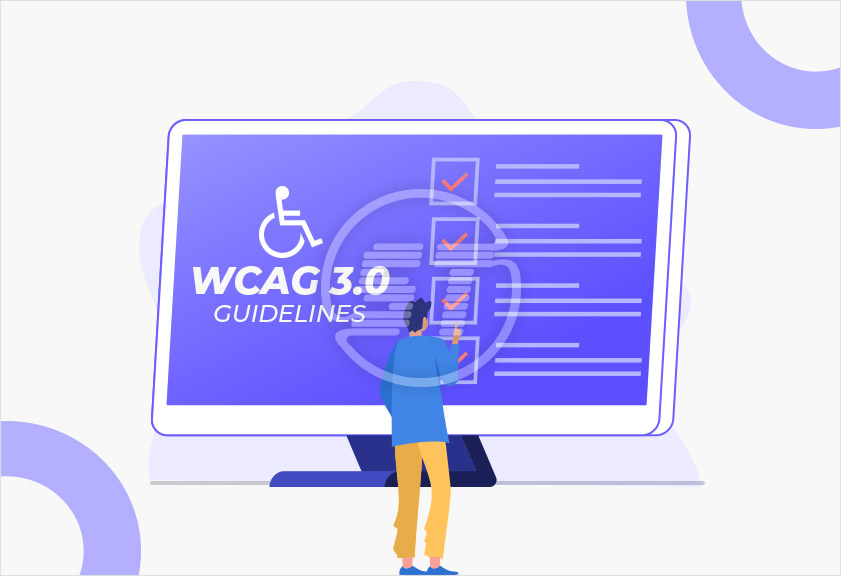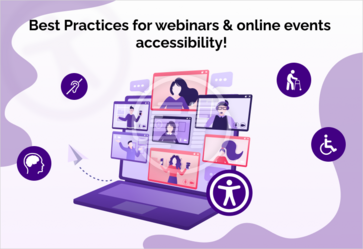What you need to know about WCAG 3.0 guidelines?
As technologies are evolving, accessibility standards must get revamped to serve users accurately. W3C supports a vast array of users’ needs and to keep pace with accelerating technological changes, it has all set to provide WCAG 3.0 standards for accessibility.
The latest guidelines will provide more accessible content for users with every sort of disability including vision impairments, hearing loss, dexterity, speech disability, sensory disorder, cognitive and learning disabilities, or a combination of these issues.
WCAG 3.0 (W3C accessibility guidelines 3.0) is the successor of WCAG 2.2 and previous versions, yet it does not deprecate WCAG 2.X. It will also include content from and partially extend User Agent Accessibility Guidelines 2.0 and Authoring Tool Accessibility Guidelines 2.0. These versions are providing accessibility for a longer span, however, transforming technologies and changing users’ needs required a new set of guidelines to make content more flexible and comprehensible.
The latest WCAG 3.0 may release in 2023. But before it will arrive, let us know what is going to be new with this upcoming version.
Is WCAG 2 series going to be obsolete?
We are adhering to WCAG 2.0 and 2.1 as of now for website accessibility. And the next version Web Content Accessibility Guidelines (WCAG) 2.2 will probably hit the floor in December 2022, which will be the final version of the WCAG 2 series. However, there is no need to panic because the new series (3.0) might get delayed. And even if it will release on time, the WCAG 2 series will not be deprecated.
Both might be parallel standards. Thus, if your website is compliant with WCAG 2.2, it will not get tested against WCAG 3.0, unless you wish to raise the standards of your website. So, WCAG 2 series is not going anywhere, 3.0 will be added advantage for us.
The difference between WCAG 2.x and WCAG 3.0:
| WCAG 2.x | WCAG 3.0 |
|---|---|
| Web Content Accessibility Guidelines | W3C Accessibility Guidelines |
| Core Principles | Design principles |
| Success Criteria | Outcomes |
| Conformance Level (A, AA, AAA) | Conformance Level (Bronze, Silver, and Gold) |
| Backward and forward compatible | Not backward compatible |
What is the need for WCAG 3.0?
Whenever any latest version gets released, it is a more focused and advanced version than its predecessors. Similarly, WCAG 3.0 will address the challenges that are bottlenecks in current versions. The key reasons why WCAG 3.0 is releasing are:
Changes in technologies
WCAG 2.0 was released back in 2008. Since then, technology has evolved to the next level. Though version 2.1 arrived to us in 2018. But technologies are transforming at a faster pace. Therefore, the standards should be compatible with the new and modern technologies and devices.
WCAG 3.0 might focus on mobile, wearable gadgets, and other Internet of Things (IoT) technologies. The Accessibility Guidelines Working Group (AGWG) is also getting into virtual and augmented reality. And in order to maintain the vast scope of website accessibility, the name of WCAG 3.0 is different from WCAG 2. WCAG 3 is W3C accessibility guidelines.
Enhancement of inclusivity
Until now the WCAG standards are focused on a limited set of disability issues. Yet there are many other users with different problems. AGWG recognized the needs of such users and take the responsibility to provide complete accessibility.
According to the editor’s draft of the WCAG 3.0 explainer, there are functional categories of disabilities, which are
- Vision and Visual
- Hearing and Auditory
- Sensory Intersections
- Mobility
- Motor
- Physical and Sensory Intersections
- Speech
- Attention
- Language and Literacy
- Learning
- Memory
- Executive
- Mental Health
- Cognitive and Sensory Intersections
These are the areas that AGWG is committed to cover in WCAG 3.0.
Readability
WCAG 2 series is a little hard to understand and which is why people does mistakes while working on accessibility standards. Since the stakeholders come from diverse backgrounds and distinct technical knowledge, therefore WCAG 3.0 will be easy to understand.
Categorization of current standards
In WCAG 3.0, the Success Criteria from WCAG 2 series will be called Outcomes.
Have a look at two criteria from WCAG 2.2:
- # Success Criteria 2.4.6 Headings and Labels: Headings and labels describe the topic or purpose.
- # Success Criteria 2.4.10 Section Headings: Section headings organize the content.
These two will be merged in WCAG 3.0. Thus, the Heading outcome will look like this
- Structured Content
- Guideline: Use sections, headings, and sub-headings to organize content.
- Outcome: Headings organize content into logical blocks with headings relevant to the subsequent content. This makes content easier to locate and navigate information more quickly.
- The augmentation of headings and sections into a sole Outcome and moving the labels out is an impressive change because WCAG 2.2 is full of labels.
Scoring
In WCAG 2 series, the result of the success criteria test is pass or fail, and no more other option. And the scoring was based on WCAG compliance levels A, AA, and AAA. A website needs to meet at least AA standards to be compliant, and AAA is an additional advantage for the website.
In WCAG 3.0, scoring is different, and the score is not only based on standards, but also on functional categories. In short, the final score depends on how well a website and its content accommodate users with learning, speech, and memory challenges.
More about WCAG 3.0 scoring system
Before you get into the scoring system, let’s know a few added terms that are introduced in WCAG 3.0.
Atomic tests: Accessibility tests can be done manually or automated. For instance, test against the Success Criteria of the WCAG 2 series or the Outcomes in WCAG 3.0.
Holistic tests: These are the real-world accessibility tests, that mainly occur with assistive technology tools. The holistic tests require to have higher scoring because they are customer acceptance tests.
Functional categories: As mentioned above in the article.
Rating: The grades are given for individual Outcomes, functional categories, and the final average score.
Conformance: The three conformance levels are – Bronze, Silver, and Gold.
Critical error: If an individual Outcome violet the accessibility standard and results in a critical error, then the rating is 0 for the corresponding standard.
Rating Outcomes
Each Outcome has some Rating in between 0 to 4. Zero is nothing but a failing score, though each score has a threshold. As mentioned above, if there is any critical error for an Outcome, it will get a Zero.
The possible ratings can be:
Rating 0 – (Very Poor) if less than 60% of all the images have proper alt texts or there is some critical error in the process.
Rating 1 – (Poor) 60 to 69% of images have alt texts and no critical error.
Rating 2 – (Fair) 70 to 79% of all images have alt texts and no critical error.
Rating 3 – (Good) 80 to 94% of all images have alt texts and no critical error in the process.
Rating 4 – (Excellent) 95 to 100% of all images have proper alt texts and no critical error in the process.
The Rating will depend on the average score of all the Outcomes, which will be the final score of the website. And the final score will determine the conformance of that website.
Rating Functional Categories
Functional Categories Rating is not clear as of now because each Outcome has a set of Functional Categories that will be addressed by the standards. Since every Outcome gets a Rating and all the Outcomes have Functional Categories associated with them, maybe the average of each Functional Category score will be that Outcome’s score.
Conformance
As stated above, three conformance levels are Bronze, Silver, and Gold. However, it is not clear how websites will earn these levels.
AGWG working draft says Bronze is the minimum conformance level. If content does not meet the requirements of even bronze level, then it will not conform to WCAG 3.0.
Draft also includes
Bronze: The total score of content and score within the functional categories must be at least 3.5 and views and processes must not have critical errors.
Silver: All views should fulfil the bronze criteria and the holistic test will play a significant role that we will get to know in a future draft.
Gold: All views must fulfil silver criteria and the use of the holistic test will be clear in a future draft.
What are you ought to do until WCAG 3.0 is released?
Though it is too early to prepare for WCAG 3.0, there is no harm in keep updating the content. WCAG always gives priority to accessibility irrespective of its version. So, by the time, WCAG 3.0 will arrive, stick to the below steps.
Get compliant with WCAG 2.1 and start looking for version 2.2. If the content will be compliant with 2.2 then taking a leap to version 3.0 will not be a problem.
Keep checking the AGWG updates for upcoming versions.
Be ready to make a switch.
Are your business website and other digital assets ADA compliant? Or are you looking for guidance on ADA web accessibility standards? All these you are in search of are available here at Skynet Technologies. As a prominent ADA website accessibility service provider, Skynet Technologies will guide you and help you make your business website and any other digital assets ADA compliant. Get in touch with us at hello@skynettechnologies.com or submit the following request free quote form to know more.


